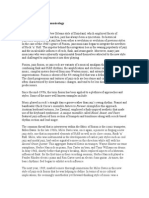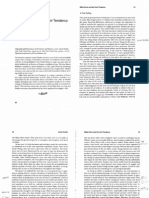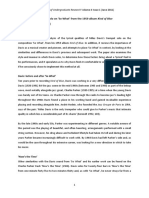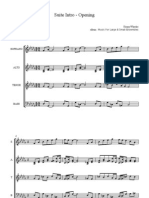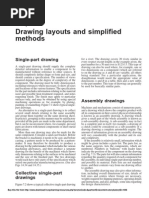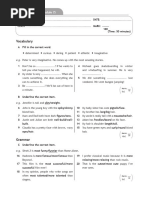Cool Jazz
Cool Jazz
Uploaded by
Alexandra MoldovanCopyright:
Available Formats
Cool Jazz
Cool Jazz
Uploaded by
Alexandra MoldovanOriginal Title
Copyright
Available Formats
Share this document
Did you find this document useful?
Is this content inappropriate?
Copyright:
Available Formats
Cool Jazz
Cool Jazz
Uploaded by
Alexandra MoldovanCopyright:
Available Formats
Jazz Trends in the 1950s
During the 1950s, new variations of bebop arose. The end of the 1940s had already
seen the cubop and progressive jazz develop out of bebop, but these variations did not differ
greatly from bebop itself. In the 1950s, two major new trends in jazz surfaced, namely cool
jazz and hard bop, often called west coast jazz and east coast jazz, respectively. The soul
jazz movement would later evolve as a minor variation of hard bop, and offshoots of cool jazz
became known as third stream, a new type of orchestral jazz.
1948-1953: COOL JAZZ & THE WEST COAST
1. Introduction
Cool jazz is a jazz style which began in the 1940s among white musicians in New
York and then moved on to California. Within cool jazz we recognize three different trends:
the group of musicians around Lennie Tristano, the group of musicians around Miles Davis
and Bill Evans and lastly the people on the west coast. There is of course no strict divide
among these groups, as Gerry Mulligan played initially in Miles Daviss group and later
became one of the leading figures of the west coast style. Lee Konitz played with Miles Davis
and with Lennie Tristano, too.
The label cool refers to a style rather than actual musical content. The compositions
the cool musicians played often feature be-bop-like chord changes and melodies, but the
interpretation and playing style differs. Cool jazz does not signal a conscious break from the
be-bop idiom, but rather its further evolution. Several cool musicians, such as Max Roach,
Milt Jackson and Miles Davis even featured in the be-bop tradition in their own rights.
2. Characteristics
1. A restrained musical style, with no expressionist ballast or pathetic effects
2. The horns use little vibrato and play mostly in the middle register
3. The influence of classical music: polyphony and complex harmony, the use of instruments
which are a-typical for jazz, such as the cello the French horn, the use of odd measures.
4. The use of arrangements and extensive attention to nuances of sound, experimenting with
new combinations of instruments.
5. The rhythm section is restrained but supportive.
3. Bebop versus Cool Jazz
1. After the raw energy of bebop, cool jazz signals a return to a more controlled, less
emotional style.
2. Cool jazz made jazz popular again after bebops elitism
3. Although cool jazz is played by both black and white musicians, the young, white
musicians dominate, whereas bebop had been embraced mainly by black musicians.
4. Cool jazz incorporated an intellectual dimension, characterized by interest in European
chamber music and contemporary classical music by, for example, Stravinsky and Debussy.
This is in great contrast to the bebop movement, which emphasized black roots, the African-
American jazz tradition and the blues.
5. Cool jazz pays more attention to color than bebop did. There is more variation in the
instruments which make up the groups.
Although bepop marked a definite break with what had come before, it still retained 'hot'
aspects from the swing period. These disappeared with the advent of cool jazz. Instead of a
return to the Afro-American sources of inspiration we saw in the bebop period with its
incorporation of Afro-Cuban jazz, cool jazz sparks an interest in European chamber music
and contemporary classical music such as the music of Stravinsky and Debussy, which adds a
sophisticated dimension to the music. This interest in classical music was expressed in the use
of polyphonic forms and complex rhythms. A good theoretical knowledge of music was
required to play cool jazz, which led to a more structured way of studying music theory which
in turn led to the dawn of the first jazz schools. Not only the style of playing changed, but also
the sounds being played. Bebops bright colors gave way to delicate pastel shades and original
orchestral resonance. The rhythm section became more sober and took on a more supportive
role.
4. Influences and Forerunners
4.1. Lester Young (1909-1959) tenor saxophone
Lester Young, with his relaxed swing and his distant, dreamy phrasing was an important
inspiration behind the cool style and influenced many saxophonists such as Lee Konitz, Gerry
Mulligan, Art Pepper, Warne Marsh, Paul Desmond, Stan Getz, Al Cohn, Zoot Sims, Dexter
Gordon, Jimmy Giuffre and others.
4.2. Progressive Jazz
A number of slightly more adventurous big bands, especially those headed by Woody
Herman, Stan Kenton and Claude Thornhill, showed preference for a more Westernized jazz
with extended, suite-like pieces. In their arrangements, we find ideas which seem to originate
more from Debussy than from Charlie Parker, as well as instrumentation which differed
greatly from traditional big band styles. In this way, jazz is pulled in a more Western
direction, with European roots so that cool jazz sparks interest in new types of
instrumentation, complex harmony, polyphony and counterpoint.
4.3. Woody Herman (1913-1987) clarinet, alto sax and vocals
Woody Herman led a series of big bands and in the mid 1940s he evolved in the direction of
bebop and progressive jazz with his band: "First Herd." His arranger in this period was Ralph
Burns. It is for this band that Stravinsky composed his Ebony Concerto. The band stopped
playing in 1946 but after a few months, Woody Herman founded a new group: "Second
Herd". Although Second Herd played mainly bebop, the earliest cool-jazz experiments began
with this band. In this second version of 'Herd', (many variations of the Herd would follow),
the new 'Four Brothers' sound' predominates, a style that refers to the song of the same name.
The reed section was made up of three tenor saxophones and one baritone sax that gives the
band a unique sound. The "Four Brothers musicians were: Serge Chalof on baritone
saxophone, the tenor saxophonists Zoot Sims, Stan Getz and Herbie Steward who would later
be replaced by Al Cohn. These four saxophonists all hailed from the Lester Young tradition of
a soft attack with no vibrato. The arrangements of the saxophone section consist mainly of
parallel movements in the same register, thus creating cool jazzs orchestral sound.
4.4. Stan Kenton (1912-1979), piano
Stan Kenton founded his first big band in 1941. From the outset he was determined to break
with established musical patterns. He strove to fuse his ideas about jazz together with 20th
century European symphonic music. Many well-known jazz musicians played in his band,
"Innovations in Modern Music", which was a big band with a string section. Among the best-
known jazz musicians were Art Pepper and Bud Shank on alto saxophone, Maynard Ferguson
and Shorty Rogers on trumpet and Shelly Manne on drums. A later version of the band in
1953 included Lee Konitz on alto sax, Zoot Sims on tenor sax and Frank Lino Rosso on
trombone. With this band, Stan Kenton recorded works by the contemporary composer Bob
Graettinger on the album City of Glass. The band played from 1949 to 1952 but stopped for
financial reasons, after which Kenton returned to more traditional occupations, and only
occasionally to larger orchestral compositions. Stan Kenton primarily influenced West Coast
musicians.
4.5. Claude Thornhill (1909-1965), piano and composition
In the 1940s Claude Thornhill led a big band which had a distinct sound due to the
presence of a bass clarinet, a French horn and a tuba. Gerry Mulligan and Lee Konitz were
the bands principal soloists. Thornhills arrangements were unique thanks to the use of
instruments normally associated with classical music, as well as to unique combinations of
sound and static sound masses in the low register with no vibrato. The Canadian Gil Evans
arranged for this band and it is especially his arrangement of the song Anthropology which
inspired Miles Davis for the sound of The Birth of the Cool project.
5. The Main Centers
5.1. New York
Miles Davis (1926-1991): The Birth of the Cool sessions
In 1948 Miles Davis set up a nine-piece band for gigs at the Royal Roost, a New York club.
Due to the success of this series of concerts, the record label Capitol organized some
recording sessions in January and March of the following year (1949) as well as in March,
1950. These recordings were later grouped together under the name The Birth of the Cool.
The band members were: Miles Davis, trumpet; either Kai Winding or J.J.Johson, trombone;
Bill Barber, tuba; Lee Konitz: alto sax; Gerry Mulligan, baritone; Al Haig and John Lewis,
piano; Joe Schulman, Nelson Boyd and Al Mc Kibbon, bass; either Junior Collins, Sandy
Siegel Stein or Gunther Shuller, French horn; Max Roach and/or Kenny Clarke, drums and
for the third session Max Roach again on drums. Kenny Hagood sings vocals on one number.
The arrangements for this band were done by Gerry Mulligan, John Lewis and Gil Evans.
Miles Davis had already met Gil Evans when he made an arrangement of Donna Lee for
Claude Thornhills group. Miles was impressed by Evanss arranging style and by the subtle
color palette Evans had developed for that band. For this project Miles made use of some of
the typical features from Thornhills repertoire, such as the inclusion of the tuba and the
French horn in the brass section. Miles even took some musicians away from Thornhill's
band: Lee Konitz, Gerry Mulligan, Bill Barber and of course the arranger Gil Evans.
Musical Features Unique to The Birth of the Cool
1. Chamber music in an intimate atmosphere which distances itself from the 'hot' style
2. Discrete attacks, no vibrato, which creates a light sound
3. Because of the predominantly low-register instruments, the ensembles sound is hot. Miles
and Konitz, on trumpet and alto sax, respectively, play mainly in the mid-range.
4. The use of polyphony and counterpoint
5. The contrast between the brass section and the reed players, so typical of the swing era, is
completely absent. The horn section functions as one unit, or in the more polyphonic passages
we hear formats that are independent of the terms brass and woodwind.
6. Attention to color, using French horn and tuba.
Later collaborations between Miles and Gil Evans are the albums Miles Ahead in 1957,
Porgy and Bess from 1958 and Sketches of Spain from 1959. These albums are in sync with
the Third Stream movement of the late '50s. In addition there is the less successful album
Quiet Nights from 1962.
The Modern Jazz Quartet, MJQ
The Modern Jazz Quartet was one of Miles Daviss groups. John Lewis (1920-2001) was
the Modern Jazz Quartets pianist, and he also played in the Birth of the Cool project. Some
members of the MJQ had already been influential to bebop: Milt Jackson (1923-1999) had
played with Dizzy Gillespie and John Lewis had played not only with Dizzy but also with
Charlie Parker. The MJQs set-up, with vibraphone, piano, bass and drums, is original for the
absence of horns. The group functioned as a unit without a real star. MJQ created an intimate
atmosphere through mixing vibraphonist Milt Jackson's blues with European baroque music.
The pianist John Lewis played rondos and Bach-like fugues. The other band members were
Percy Heath (1923-2005) on bass and Connie Kay (1927-1994) on drums. The group lasted
from 1954 to 1974. After a hiatus in the early 1980s, the band reunited annually to tour for a
few months. John Lewis in particular gained fame not only as leader of the MJQ but also for
his role in the "Third Stream" movement.
Lennie Tristano (1919-1978), piano
The Chicago-born pianist, composer and pedagogue Leonard Joseph Tristanos musical
oeuvre dates almost entirely from the cool jazz era. Blind from the age of nine, Tristano's
affliction did not prevent him from training in classical music. In 1943 Tristano obtained a
degree in piano and composition in Chicago. Shortly afterwards he became a music teacher
giving private lessons, with alto saxophonist Lee Konitz and trombonist-composer Bill Russo
among his first pupils. In 1946 Tristano moved to New York and gathered a circle of true
disciples around him. In 1951 in New York he founded The New School of Music. Tristano
recruited teachers for the school from among his original disciples, among whom Lee Konitz,
Warne Marsh and Billy Bauer. These musicians were also all members of Tristanos sextet. In
1956 Tristano closed his school and returned to private tuition. From 1965, he venturedless
and less from home and studio, concentrating on study, recording and teaching. His last public
appearance was in 1968.
Tristano gained great inspiration from Bach, but was also well versed in contemporary
classical music. That put a stamp on his harmonic ideas. Some of his recordings from the late
'40s are distinguished by their feel and already evolving toward polytonal atonality. With the
sextet he founded in 1949, Tristano wrote a number of improvisations completely free from
written themes and with no regular harmonic pattern. In numbers such as Intuition, he was
a decade ahead of the free jazz movement as well as of jazzs later more commonplace
atonality. Proponents of pure jazz criticized Tristano for his effete intellectualism and as well
as for his suppression of warmth and emotional expression. Tristano's music was indeed very
cerebral and abstract, but his critics often overlooked the fact that he really wanted to break
with a number of routine formulas and sought to develop new forms of collective
improvisation.
As a pianist Tristano demonstrates great technique and surprising timing with a remarkable
agility in both hands. We find both long, flowing phrases as well as block chords. His
influence on the cool jazz movement is apparent for example in the two-part polyphonic
improvisations in which Lee Konitz and Warne Marsh specialized which were also inspired
by Bachs counterpoint.
Stan Getz (1927-1991), tenor saxophone
Getz turned out to be one of the leading tenor saxophonists of the cool jazz era, after
joining Woody Herman as one of the pivotal 'Four Brothers', and especially thanks to his
legendary solo on "Early Autumn. Getz began his professional career at the age of 15,
performing in Jack Teagardens big band. He went on to play with Jimmy Dorsey, Stan
Kenton and Benny Goodman. After Woody Hermans band, Getz preferred to play small
ensembles. When at the end of the 1950s Getz moved for a time to Europe he became an
almost forgotten figure in the jazz scene, thanks also to his use of hard drugs. Thanks to the
bossa nova craze however, Getz made a spectacular comeback. The bossa nova was a mix of
cool jazz and Brazilian music and Getz had not the slightest difficulty making that style of
music his own. The combination of lilt and rhythm, typical of Brazilian music had always
been a facet of Getzs own personal style.
5.2. West Coast
The West Coast style was actually created in New York and imported to California by
musicians who already worked there or who moved there to work, such as Gerry Mulligan.
Essentially there is no real difference between cool jazz as played in New York and cool jazz
played on the West Coast. In the 1930s and 1940s New York City was the center of jazz, as
was Chicago to a lesser extent. In 1947 Parker recorded his famous Los Angeles Dial
Sessions and from the 1950s the West Coast became a vibrant scene for cool jazz in both Los
Angeles and San Francisco, at least for a while. From the 1950s Los Angeles became more
and more a center of film, culture and the arts in general. Many major record companies
opened offices in LA and the city became a center for jazz musicians who found work not
only in the club scene but also in the film industry as studio musicians.
Chet Baker (1929-1988), trumpet
Chet Baker enjoyed a brief stint playing with Charlie Parker in 1952 and after that he
played in Mulligans successful piano-free quartet, after which he returned to playing with
Parker for a time. From 1954 on, Chet Bakers own musical career saw many ups and downs.
As a result of his addiction to hard drugs, Baker repeatedly found himself in trouble. Initially,
Chet Baker was initially regarded as a disciple of Miles Davis, but their stylistic similarities
actually owe a lot to their common inspiration: Bix Beiderbecke. Chet Baker did not become
acquainted with Miles Daviss music until after he had already developed his own style. From
his teen years, Chet had been a fan of the bebop style and especially of Dizzy Gillespie.
Interestingly, as a result of the great amount of time he spent on the road touring, as well as,
of course and perhaps chiefly due to his unorthodox lifestyle and his many stints in jail, Chet
failed to experience first-hand many of the innovations in jazz music which occurred during
his career. Therefore, Chet Bakers style did not know the sort of evolutions which we
encounter, for example, in Miles Daviss playing. Chet Baker persistently played his own
style of intimate music and he became one of the most lyrical trumpet players in jazz history.
He frequently achieved top ranking in countless music magazine polls and left his colleagues,
such as Davis and Gillespie, far behind. In the summer of 1953 Baker won both the New Star
Award as well as Downbeat Magazines 1953 readers poll, which he won again in 1954. In
1955 and 1956 he won first place in both Melody Maker and Metronomes polls and he won
the 1958 polls for both Jazz Echo and Playboy. Chet Bakers career can be divided into three
periods: his early years which include his first successes as sideman to Parker and Mulligan
(1952-1958); the Great Depression (1959-1973); and his comeback, characterized above all
by his European successes (1974-1988).
From 1955 Baker more or less wandered through Europe. His only somewhat
fixed residence during this period was the home of the Belgian pharmacist and saxophonist
Jacques Pelzer in Lige. From 1959 to 1960 Baker spent a year and a half in an Italian prison
on drugs charges. In 1964 he returned to the states but in 1968 was forced to stop playing for
a time because he had lost his teeth in a brawl. In 1973 Baker staged a comeback and in 1975
he returned to Europe but in Amsterdam in 1988, Baker fell from a window to his death.
Dave Brubeck (1920-2012), piano and Paul Desmond (1924 -1977), alto saxophone
Dave Brubeck studied classical music and was a pupil of Arnold Schoenberg and Darius
Milhaud. Brubecks group in the early 1960s with Paul Desmond on alto, would become one
of the highest-paid jazz combos of its day. The group carried out fascinating experiments on
European classical music styles and complicated compound timing. The group remained
together until 1967 after which Brubeck concentrated more on composing.
Chico Hamilton (b. 1920), drums
Hamilton grew up in LA where during his childhood he jammed with his schoolmates
Charles Mingus, Buddy Colette, Dexter Gordon and Illinois Jacquet. Hamilton also played in
the original Gerry Mulligan Quartet with Chet Baker in 1952 and 1953. In 1955 he formed his
own quintet made up of, entirely in the cool jazz tradition, a very eccentric combination: flute
or clarinet, guitar, cello, bass and drums. Famous jazz musicians such as Eric Dolphy, Charles
Lloyd and Ron Carter all played for a while in this band.
In conclusion a few other musicians in the cool and West Coast movements must be
mentioned: Art Pepper and Bud Shank: alto sax, Jimmy Giuffre and Zoot Sims: tenor sax,
Shorty Rogers: trumpet, Frank Ross Lino, trombone, Barney Kessel and Jim Hall: guitar,
Russ Freeman: piano, Red Mitchell and Monty Budwig: bass, Mel Lewis, Shelly Manne and
Chico Hamilton: drums.
You might also like
- MASTERING Digital Dental PhotographyDocument396 pagesMASTERING Digital Dental PhotographySeher Parveen100% (3)
- Global Colour Forecast S S 24Document20 pagesGlobal Colour Forecast S S 24Raquel Mantovani80% (5)
- Eric Dolphy A Musical Biography and Discography PDFDocument2 pagesEric Dolphy A Musical Biography and Discography PDFLisa0% (3)
- JazzDocument45 pagesJazzmemirrianoide100% (1)
- Miles Davis DiscographyDocument33 pagesMiles Davis DiscographybooksfNo ratings yet
- Pata Pata Vocal Notation PDFDocument2 pagesPata Pata Vocal Notation PDFAlexandra Moldovan100% (1)
- The History of Jazz EssayDocument3 pagesThe History of Jazz Essaysingingman100% (6)
- Encyclopedia Entry of FusionDocument3 pagesEncyclopedia Entry of FusionMichaelJamesChristopherConklinNo ratings yet
- I Remember: Eighty Years of Black Entertainment, Big Bands, and the BluesFrom EverandI Remember: Eighty Years of Black Entertainment, Big Bands, and the BluesNo ratings yet
- Jazz Expose: The New York Jazz Museum and the Power Struggle That Destroyed ItFrom EverandJazz Expose: The New York Jazz Museum and the Power Struggle That Destroyed ItRating: 5 out of 5 stars5/5 (1)
- Al JarreauDocument11 pagesAl JarreauTasto BiancoNo ratings yet
- The Rhythm SectionDocument4 pagesThe Rhythm SectionMorgan Hipp100% (1)
- Recording Jazz Problems EssayDocument7 pagesRecording Jazz Problems Essaymusicessays100% (1)
- Cool JazzDocument8 pagesCool JazzjqnguyenNo ratings yet
- Jazz Fusion Style OverviewDocument8 pagesJazz Fusion Style OverviewCameronNo ratings yet
- Ornette Coleman - Wikipedia, The Free Encyclopedia PDFDocument9 pagesOrnette Coleman - Wikipedia, The Free Encyclopedia PDFricardortuzar44No ratings yet
- Stablemates (Arrangement)Document3 pagesStablemates (Arrangement)Daan DemeyerNo ratings yet
- A Study of Miles Davis's Solo On So What' From The 1959 Album Kind of BlueDocument8 pagesA Study of Miles Davis's Solo On So What' From The 1959 Album Kind of BlueAndi LicqurishNo ratings yet
- Bill EvansDocument9 pagesBill Evansvijaymusic88No ratings yet
- Rehearsal Strategies: Chinoiserie by Duke Ellington: by Prof. Ronald Carter - Northern Illinois UniversityDocument4 pagesRehearsal Strategies: Chinoiserie by Duke Ellington: by Prof. Ronald Carter - Northern Illinois UniversityCarlos Ferreyra-GonzalezNo ratings yet
- Be Bop Supersax DizzyGillespieDocument31 pagesBe Bop Supersax DizzyGillespieValentina RamunnoNo ratings yet
- Jin y December 13 Web FinalDocument80 pagesJin y December 13 Web Finalcharlie123No ratings yet
- Mu2404 Assignment KobDocument15 pagesMu2404 Assignment Kobphiltovell49100% (1)
- Herbie Hancock DiscographyDocument27 pagesHerbie Hancock DiscographybooksfNo ratings yet
- Bemsha SwingDocument27 pagesBemsha Swingr-c-a-d100% (3)
- Billy Eckstine: William Clarence Eckstine (July 8, 1914 - March 8, 1993)Document8 pagesBilly Eckstine: William Clarence Eckstine (July 8, 1914 - March 8, 1993)booksfNo ratings yet
- Jazz 123Document58 pagesJazz 123Nicolás Fernando Jaimes RuizNo ratings yet
- Dr. John Insides Out BAMDocument9 pagesDr. John Insides Out BAMGeorge De StefanoNo ratings yet
- Oscar PetersonDocument9 pagesOscar PetersonIvana Halingkar0% (1)
- View ContentDocument236 pagesView ContentGordon FreemanNo ratings yet
- Swingin' The Samba (Blue Mitchell's Solo)Document2 pagesSwingin' The Samba (Blue Mitchell's Solo)Juan Pablo SalmoiraghiNo ratings yet
- Hank Jones - DiscographieDocument71 pagesHank Jones - DiscographieBastien Brison0% (2)
- History of Jazz 1930-1940Document2 pagesHistory of Jazz 1930-1940Charlotte MarlowNo ratings yet
- Jazz History 60s and 70sDocument51 pagesJazz History 60s and 70smariaNo ratings yet
- Day 3 Embraceable UDocument20 pagesDay 3 Embraceable UShunya AramakiNo ratings yet
- Ladybird DameronDocument4 pagesLadybird Dameronapi-277836418100% (1)
- Autumn Leaves - ReharmonizationDocument1 pageAutumn Leaves - ReharmonizationJacob GatesNo ratings yet
- Blue in Green: B A D DDocument3 pagesBlue in Green: B A D DNO TIMENo ratings yet
- Jazz Play-Along Volume 86 - Benny Goodman (X)Document6 pagesJazz Play-Along Volume 86 - Benny Goodman (X)Elisa PortillaNo ratings yet
- A Sleeping BeeDocument13 pagesA Sleeping BeeJesse AudeloNo ratings yet
- Chord Scale TheoryDocument2 pagesChord Scale TheoryLuis Nuño100% (1)
- The Music:: Jeff Sultanof, Doug Duboff, Rob Duboff, and Sonjia StoneDocument1 pageThe Music:: Jeff Sultanof, Doug Duboff, Rob Duboff, and Sonjia StoneFabio PavanNo ratings yet
- Improvise For Real: Piano Trio Piano TrioDocument5 pagesImprovise For Real: Piano Trio Piano TrioSimbinewindNo ratings yet
- Voicings - Mel MartinDocument5 pagesVoicings - Mel MartinAnonymous gZoIU7ZNo ratings yet
- Lady Bird: C D E C FDocument2 pagesLady Bird: C D E C FAurelio FragapaneNo ratings yet
- Woodwind HandbookDocument29 pagesWoodwind HandbookwvanderhovenNo ratings yet
- Dexter GordonDocument12 pagesDexter GordonbooksfNo ratings yet
- History of Nigerian JazzDocument55 pagesHistory of Nigerian JazzburgundioNo ratings yet
- LADY IRIS B-PianoDocument1 pageLADY IRIS B-Pianovalentin foulonNo ratings yet
- Charlie Christian - ReferenceDocument6 pagesCharlie Christian - Referencejoao famaNo ratings yet
- Excerpt: Beyond A Love Supreme' by Tony WhytonDocument8 pagesExcerpt: Beyond A Love Supreme' by Tony WhytonOnPointRadioNo ratings yet
- A Historical and Critical Survey of Recent Pedagogical Materials For The Teaching and Learning of JazzDocument24 pagesA Historical and Critical Survey of Recent Pedagogical Materials For The Teaching and Learning of Jazzr-c-a-dNo ratings yet
- Goodnight My Love LeadDocument1 pageGoodnight My Love LeadEmilio Bueno SalazarNo ratings yet
- Eddie HigginsDocument4 pagesEddie Higginsjoao famaNo ratings yet
- Epitaph (Charles Mingus Composition)Document6 pagesEpitaph (Charles Mingus Composition)PauloHenriqueRibeiro0% (1)
- Green Dolphin Street Transcription ExerciseDocument2 pagesGreen Dolphin Street Transcription ExerciseClases Guitarra Rock PopNo ratings yet
- Parker, Charlie (Charles, JR Bird Chan, Charlie Yardbird)Document12 pagesParker, Charlie (Charles, JR Bird Chan, Charlie Yardbird)bob100% (1)
- Wavedash Solo - Rob Araujo - SoundsliceDocument1 pageWavedash Solo - Rob Araujo - SoundsliceGermánTruccoNo ratings yet
- Australian JazzDocument18 pagesAustralian JazzKaterina LaskovaNo ratings yet
- Charles Mingus - Penguin Jazz 5thDocument10 pagesCharles Mingus - Penguin Jazz 5thDiego RodriguezNo ratings yet
- Jazz Play-Along Volume 106 - Slo' Jazz (X)Document6 pagesJazz Play-Along Volume 106 - Slo' Jazz (X)Elisa PortillaNo ratings yet
- Everybody Song But My Own: C - DianaDocument2 pagesEverybody Song But My Own: C - DianaAzzurra CuonzoNo ratings yet
- Anything You Can TextDocument4 pagesAnything You Can TextAlexandra MoldovanNo ratings yet
- Sweet DulcineaDocument1 pageSweet DulcineaAlexandra MoldovanNo ratings yet
- '60's in JazzDocument25 pages'60's in JazzAlexandra MoldovanNo ratings yet
- 4.'70s in JazzDocument18 pages4.'70s in JazzAlexandra MoldovanNo ratings yet
- Suite IntroDocument2 pagesSuite IntroAlexandra MoldovanNo ratings yet
- Possible EEDocument2 pagesPossible EEwilliamNo ratings yet
- Template Jifo 2021Document4 pagesTemplate Jifo 2021mechzgaming880No ratings yet
- Textile Testing and Product EvaluationDocument64 pagesTextile Testing and Product EvaluationBhaswati Panda100% (1)
- Atril Director - Wenger - Flex Conductors Stand-Basket Acc - Assembly - 236C128Document2 pagesAtril Director - Wenger - Flex Conductors Stand-Basket Acc - Assembly - 236C128Produccion ProartesNo ratings yet
- Basic Taekwondo TerminologyDocument1 pageBasic Taekwondo TerminologyKrystal Castañeda0% (1)
- Sun Temple, GujratDocument11 pagesSun Temple, GujratSejal MengajiNo ratings yet
- Drawing Issue Sheet: Discipline CFC Hotels DevelopmentsDocument22 pagesDrawing Issue Sheet: Discipline CFC Hotels DevelopmentsAmr EidNo ratings yet
- Narrative VNXXDocument6 pagesNarrative VNXXJam CuntapayNo ratings yet
- Fernando Amorsolo Case StudyDocument8 pagesFernando Amorsolo Case StudyYehoshua Jehiel AdoniramNo ratings yet
- The Importance of Art AppreciationDocument1 pageThe Importance of Art AppreciationColeen gaboy0% (1)
- 2410 5915acbb6ac74-2017-05-12 Press KitDocument32 pages2410 5915acbb6ac74-2017-05-12 Press KityeyosanchezNo ratings yet
- Primary Curriculum Framework 2018Document27 pagesPrimary Curriculum Framework 2018Edson HoNo ratings yet
- Interior LightingDocument122 pagesInterior LightingSofia Rodrigues100% (19)
- Session 4-Art ExhibitionDocument37 pagesSession 4-Art ExhibitionCrisencio M. PanerNo ratings yet
- Little BearDocument4 pagesLittle Bearnguyenhongv8No ratings yet
- FilePages From 7. Drawing Layouts and Simplified MethodsDocument4 pagesFilePages From 7. Drawing Layouts and Simplified MethodsNagendra DugginaNo ratings yet
- 1 Groot Handelsgebouw: H.A. Maaskant and W. Van Tijen (1947-1953)Document7 pages1 Groot Handelsgebouw: H.A. Maaskant and W. Van Tijen (1947-1953)Irina UsatyiNo ratings yet
- Drawing and Painting I Scope and SequenceDocument6 pagesDrawing and Painting I Scope and SequenceYãbeçk MâmNo ratings yet
- BA 1 (Dec 2020) PassDocument902 pagesBA 1 (Dec 2020) PassManish KhatriNo ratings yet
- MID QDDocument5 pagesMID QDrenjomarNo ratings yet
- The Origins of Low-Fire Polychrome Glazed Pottery in ChinaDocument8 pagesThe Origins of Low-Fire Polychrome Glazed Pottery in Chinasnickercat.meowNo ratings yet
- Special Rules For Tamil Nadu Handlooms and Textiles ServiceDocument227 pagesSpecial Rules For Tamil Nadu Handlooms and Textiles Servicepratik_rohit100% (1)
- Artist Statement For Grade 11Document3 pagesArtist Statement For Grade 11api-588269790No ratings yet
- Music and Art Course OutlineDocument4 pagesMusic and Art Course OutlinefreedomindependenceNo ratings yet
- Karate HandbookDocument58 pagesKarate Handbookjose.oliverosflacNo ratings yet
- 09 Module Test 7 ACTION 3Document4 pages09 Module Test 7 ACTION 3veerinpatjongchamchoyNo ratings yet
- Reality, Destruction, and Acceptance: An Analysis of The Berceuse, From Quatre Chants PorDocument19 pagesReality, Destruction, and Acceptance: An Analysis of The Berceuse, From Quatre Chants PorLucas Velázquez100% (1)
- Louvre Residences V10 DubaiDocument63 pagesLouvre Residences V10 DubaiTanya VolkovaNo ratings yet







